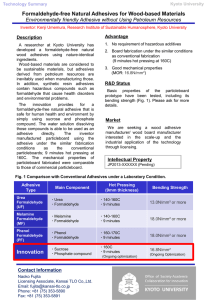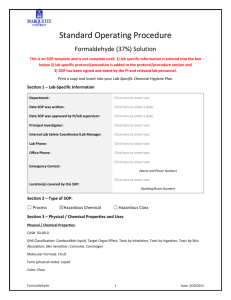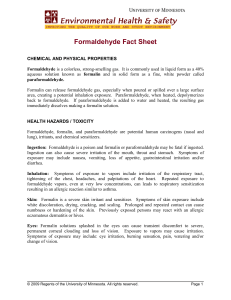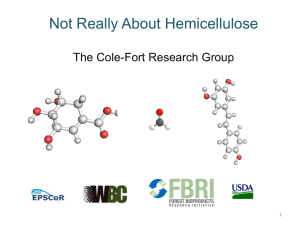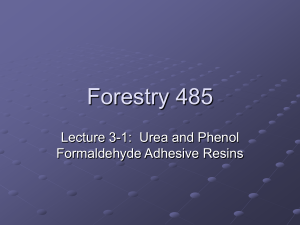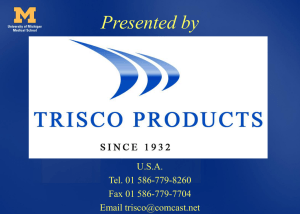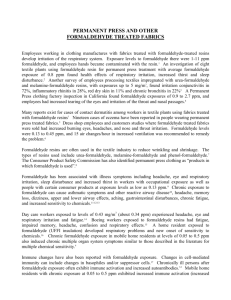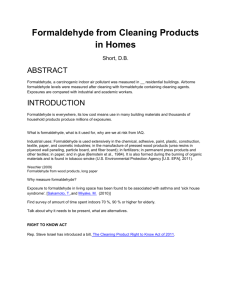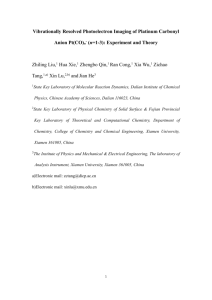Formaldehyde - US
advertisement
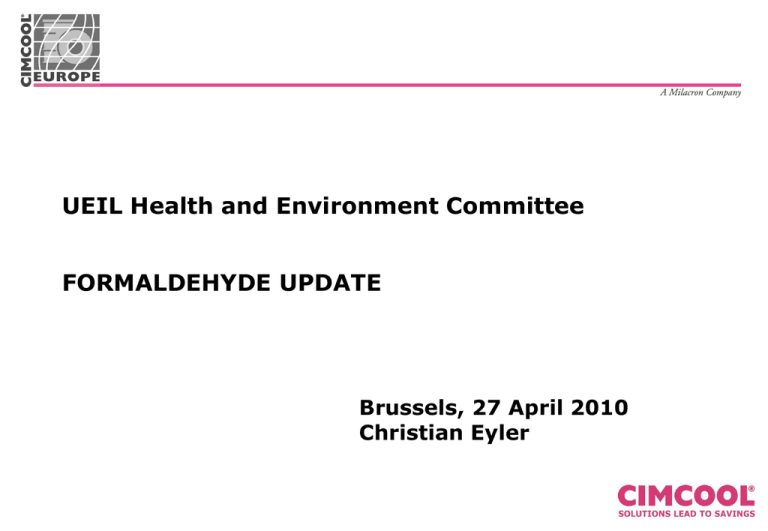
UEIL Health and Environment Committee FORMALDEHYDE UPDATE Brussels, 27 April 2010 Christian Eyler Formaldehyde France - Legal Situation • Formaldehyde releasers added to the list of cancerogene substances • Workers should not be exposed to these substances • Application from 1st Jan 2007, in France only • The employer is obliged to 1. Replace by FormaldehydeFree product if technically not possible: 2. Actions to limit the exposure of workers to a minimum, e.g. - encapsulate the machines - regular measurements - regular medical checks - etc. Proposal for harmonised C&L by France France is expected to submit a new proposal for harmonised classification and labelling for formaldehyde to ECHA by end of September 2010. In December 2009 the submission date had been postponed for 9 months in order to take into account the results of the IARC meeting in October 2009. In their October 2009 meeting in Lyon IARC concluded in a split vote that there is sufficient evidence in humans of a causal association of formaldehyde with leukemia (ZHANG study(!?)). From FormaCare’s scientific perspective, the main focus will remain Nasopharyngeal Cancer (NPC), as confirmed unanimously by IARC in October 2009. Leukemia could be taken up by France to further strengthen the case for a stricter classification than the current category in Europe. This science-based exchange by FormaCare will be pursued vis-à-vis the European Commission, where high-level dialogue has already commenced and with the competent authorities of key Member States such as France, Germany and the UK. The role of Germany will be very decisive as rapporteur in ECHA’s Risk Assessment Committee (RAC) on the French Dossier. Indoor Air Quality – WHO/EU WHO expected to maintain limit values, EU guidelines still under review. Work on guideline values established by the World Health Organization (WHO) for indoor air quality is almost finished. The final version of the WHO publication is expected to be available end of the second quarter of 2010 and will be taken into account by the European Commission. If no change is made, which is still possible until end of April, it seems as if the current values (0.08 ppm = 0.10 mg/m³) of the WHO will be maintained. For reference, BG Guideline MWF median and CRAM France results general average exposure = 0.02 mg/m³!!! This is important since the European Commission’s preparatory work on indoor air limit values so far generated very different results and conclusions. We are now waiting for the revised version of the European Commission Joint Research Centre’s (JRC) INDEX report which is thought to take WHO results into account. FormaCare is planning to participate via CEFIC in a workshop in June to discuss and promote a "Harmonised Framework on indoor material labelling schemes“ for Europe. OEL-setting process New proposal by SCOEL after study results in 2010, DNEL to be derived in parallel Once results of the current inhalation study with human volunteers are available presumably by autumn 2010 - a new evaluation will be performed by the Scientific Committee on Occupational Exposure Limits (SCOEL). This review will then be put to consultation in a first step. The Commission could aim to establish occupational exposure limit values (OEL) for the workplace that are indicative or binding. In parallel, FormaCare will develop a so-called DNEL (Derived No-Effect Level) for formaldehyde required under REACH. Manufacturers and importers must calculate DNELs as part of their Chemical Safety Assessment (CSA) for any chemicals used in quantities of 10 tonnes or more per year. OEL-setting process As part of the human health risk assessment DNELs are established based on the available data on the intrinsic toxicological properties of a substance. The DNEL describes the dose which is safe for humans, meaning that any exposure at or below the DNEL will not lead to adverse effects and can be regarded as a safe level for humans. For all possible exposure scenarios, including exposure at the workplace during production or use, the estimated exposure level will be compared with the DNEL. If the exposure equals or is below the DNEL, the identified use is safe and no additional measures have to be implemented. Given that DNELs are not very different from OELs, ECHA’s RAC closely coordinates its work with SCOEL to achieve possible alignments between the bodies’ activities with regard to the setting of limit values. DNELs are thought to succeed OELs at some point. But in an interim phase some questions regarding the relationship between OELs to be established at EU-level, existing OELs at national levels and the DNEL remain and require investigation and clarification in the course of the next months. Formaldehyde - US The U.S. Environmental Protection Agency (EPA) is currently working on the IRIS (Integrated Risk Information System) assessment of formaldehyde. In December 2009, the U.S. Environmental Protection Agency (EPA) notified FCI that the National Academy of Sciences (NAS) will be asked to serve as the peer review body for EPA's ongoing IRIS assessment of formaldehyde. The external peer review by NAS is expected to start in autumn 2010 to be completed in spring 2011. The final assessment under IRIS is expected to be completed by the second half of 2011. In February 2010, FCI addressed the EPA to begin a dialogue about some of the science issues that have been raised recently concerning formaldehyde. FCI made it very clear that industry takes its responsibility to help provide a scientific basis for public health protection very seriously. At the same time concerns were expressed, that several fundamental key science issues have not received sufficient critical attention. According to FCI, those issues are quite likely to be raised by the National Academy of Sciences committee that will review formaldehyde’s IRIS profile. Formaldehyde - US Furthermore, in March 2010, the U.S. House of Representatives’ Subcommittee on Commerce, Trade, and Consumer Protection held a hearing on the Formaldehyde Standards for Composite Wood Products Act. FCI Executive Director, Betsy Natz, attended the hearing in which no mention was made of leukemia. End of 2009, the National Institute of Environmental Health Sciences NIEHS, a part of which is the National Toxiocology Programme (NTP), nominated formaldehyde for possible reconsideration as a “known carcinogen." FCI submitted extensive comments to the NTP’s recommendation on formaldehyde. NTP has now scheduled the Board of Scientific Counselors meeting June 20 – 21 2010, which will be held at NIEHS headquarters in Research Triangle Park, NC. FCI will identify key scientists to present at the meeting as well as formulate written comments Formaldehyde - Europe Actions: - Contact established between Reinhard Strupp and Michael Rocker (26 April 2010) - Meet with FormaCare/R.Strupp in Paris on 4 May 2010
